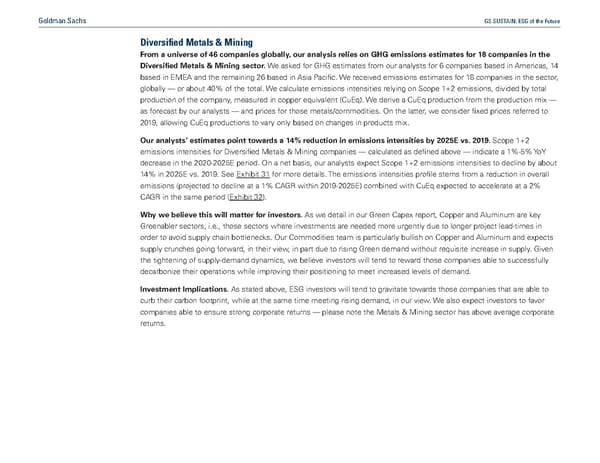Goldman Sachs GS SUSTAIN: ESG of the Future Diversified Metals & Mining From a universe of 46 companies globally, our analysis relies on GHG emissions estimates for 18 companies in the Diversified Metals & Mining sector. We asked for GHG estimates from our analysts for 6 companies based in Americas, 14 based in EMEA and the remaining 26 based in Asia Pacific. We received emissions estimates for 18 companies in the sector, globally — or about 40% of the total. We calculate emissions intensities relying on Scope 1+2 emissions, divided by total production of the company, measured in copper equivalent (CuEq). We derive a CuEq production from the production mix — as forecast by our analysts — and prices for those metals/commodities. On the latter, we consider fixed prices referred to 2019, allowing CuEq productions to vary only based on changes in products mix. Our analysts estimates point towards a 14% reduction in emissions intensities by 2025E vs. 2019. Scope 1+2 emissions intensities for Diversified Metals & Mining companies — calculated as defined above — indicate a 1%-5% YoY decrease in the 2020-2025E period. On a net basis, our analysts expect Scope 1+2 emissions intensities to decline by about 14% in 2025E vs. 2019. See Exhibit 31 for more details. The emissions intensities profile stems from a reduction in overall emissions (projected to decline at a 1% CAGR within 2019-2025E) combined with CuEq expected to accelerate at a 2% CAGR in the same period (Exhibit 32). Why we believe this will matter for investors. As we detail in our Green Capex report, Copper and Aluminum are key Greenabler sectors, i.e., those sectors where investments are needed more urgently due to longer project lead-times in order to avoid supply chain bottlenecks. Our Commodities team is particularly bullish on Copper and Aluminum and expects supply crunches going forward, in their view, in part due to rising Green demand without requisite increase in supply. Given the tightening of supply-demand dynamics, we believe investors will tend to reward those companies able to successfully decarbonize their operations while improving their positioning to meet increased levels of demand. Investment Implications. As stated above, ESG investors will tend to gravitate towards those companies that are able to curb their carbon footprint, while at the same time meeting rising demand, in our view. We also expect investors to favor companies able to ensure strong corporate returns — please note the Metals & Mining sector has above average corporate returns.
 GS SUSTAIN: ESG of the Future Page 43 Page 45
GS SUSTAIN: ESG of the Future Page 43 Page 45